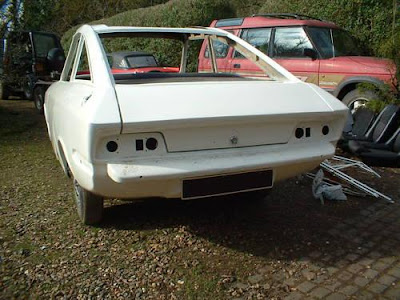When I purchased the car, I was not given any history. In fact, the wrecking yard had acquired the car in 2001 and listed it as a Financial Write-Off, returning the plates and destroying all documentation. Needless to say, the registration authorities were deeply sceptical until one kind chap took it on himself to research the car, finding it registered in South Australia since almost new, last registered in 1986.
I breathed a sigh of relief, I can tell you.
At this point I appealed to others for information also. A response via the Triumph Sports Owners Association of South Australia mentioned that they had seen the car for sale in the late 1990's (at that stage running quite well apparently), the elderly (original) owner claiming his wife had reversed into a brick wall at high speed!
So, that seems to be the reason for all this mess - she certainly must have been travelling!
Amongst the last, but certainly not the least of the rear end damage casualties, was the fuel tank. The tank had been partially dislodged in the accident, damaging some of the mounting points and creasing the tank at several points...hence it took about 6 hours to remove it! As the tank came from a Triumph Herald Estate or Courier (Herald Van - extremely rare), there was little hope of finding a replacement laying under a tree, so repair was the only option.
After a 6 hours armwrestle, we extracted this ugly thing
The tank had an ominous looking crease at one point, which had bowed the top of the tank upwards, so that it would not be possible to refit beneath the fibreglass false floor of the Equipe (broken into pieces - another job for Norm and I). Luckily, there was no leak, but would need to be retested after the crease had been pulled out.

Being punted on the seam had buckled the top nicely. In addition to not fitting under the false floor, I'm not sure the fuel sender would read properly - I'd likely be out of fuel constantly!
My first port of call requested $800 to straighten the tank, with no guarantee of successful repair. When I had finished laughing, I had the tank blasted and etch primed, then approached some local panel beaters. No-one was super keen, and I was beginning to despair when I heard of a chap North or Adelaide who repaired motorcycle tanks. One week and $75 later, the tank came back straightened and flat again - not perfectly dent free, but given its location deep inside the boot, I was prepared to let this one slide. No leak, that was the main thing.
Not perfectly straight, but flat and safe - a giant relief
Of course, I'm sworn to secrecy over the repair technique, but suffice to say it was very clever. Very happy with the results for my meagre investment.
About 18 months on, it remains yet to be painted, but there's no rush. The sender was tested and worked fine, the whole lot sits in the garage awaiting re-assembly.


